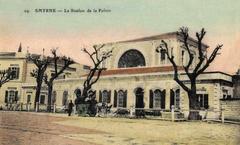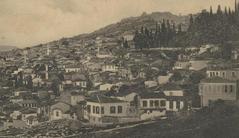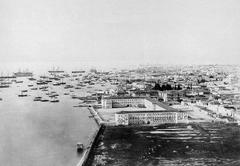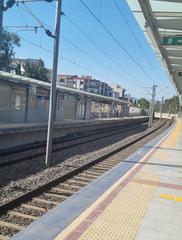İzmir Archaeological Museum: Complete Visitor Guide, Tickets, Hours & Highlights
Date: 03/07/2025
Introduction
Nestled in İzmir’s lively Konak district, the İzmir Archaeological Museum is a premier destination for anyone eager to explore the ancient civilizations of Western Anatolia. Since its origins in 1927, the museum has grown into a modern institution, now hosting over 5,000 artifacts spanning from the prehistoric era to Byzantine times. Its carefully curated collections, drawn from major sites such as Smyrna, Ephesus, Pergamon, and Miletus, offer a fascinating journey through the millennia (İzmir Archaeology Museum - Ministry of Culture and Tourism; Hurriyet Daily News).
The museum’s thematic exhibitions and accessible design make it a must-see for scholars, families, and travelers alike. Visitors can enjoy highlights such as the iconic statue of Homer, elaborate sarcophagi, marble sculptures, and open-air displays of monumental stone artifacts. The location, set within Bahribaba Park and close to İzmir’s Clock Tower, Agora ruins, and Ethnography Museum, makes it perfect for a day of cultural exploration (İzmir Archaeological Museum - IYI Turkey; turkiyetoday.com).
This detailed guide covers everything you need to plan your visit: history, collections, visiting hours, tickets, accessibility, and travel tips.
Table of Contents
- Museum Origins and Evolution
- Collection Highlights & Thematic Exhibitions
- Notable Artifacts and Iconic Pieces
- Practical Visitor Information
- Location and Getting There
- Tips for Visitors
- Frequently Asked Questions (FAQ)
- Conclusion
- References & Further Information
Museum Origins and Evolution
Founded in 1927, the İzmir Archaeological Museum reflected the new Turkish Republic’s commitment to preserving its ancient heritage. The first collection was assembled in the Ayavukla (Gözlü) Church, later moving to Kültürpark in 1951 as discoveries from regional excavations grew. The current museum building, opened in 1984 in Bahribaba Park, was purpose-built to house the expanding collection and features exhibition halls, conservation labs, a library, and conference spaces (İzmir Archaeology Museum - Ministry of Culture and Tourism).
Collection Highlights & Thematic Exhibitions
The museum’s collection is organized thematically and chronologically, offering a narrative journey through the region’s rich history. The three main exhibition floors include:
Stone Works Hall
This hall showcases marble and stone sculptures, busts, masks, and funerary monuments from the Hellenistic and Roman periods. Notable displays include statues of deities (Aphrodite, Athena, Demeter), emperors, and intricately carved sarcophagi reflecting ancient funerary beliefs (muze.gov.tr).
Ekrem Akurgal Ceramic Works Hall
Named after the eminent Turkish archaeologist, this section traces ceramic artistry from the Neolithic through the Byzantine period. Highlights include prehistoric pottery from Yeşilova and Ulucak mounds, painted Greek vessels, and Byzantine wares reflecting the city’s long cultural evolution.
Treasury Room
The museum’s numismatic collection presents coins from the Greek, Roman, Byzantine, and Ottoman eras, illuminating the region’s economic and political history (whichmuseum.com).
Everyday Life and Domestic Artifacts
Exhibits include cooking utensils, jewelry, tools, oil lamps, and personal adornments, providing insight into daily life in ancient Anatolia (thrillophilia.com).
Glass and Metalwork
Delicate glassware and bronze ritual objects from the Hellenistic and Roman periods highlight the technical artistry of the ancient world (urtrips.com).
Inscriptions and Manuscripts
Epigraphic monuments and rare manuscripts in Greek and Latin offer a glimpse into the literacy, laws, and religious practices of ancient inhabitants.
Notable Artifacts and Iconic Pieces
- Statue of Homer: A composite Hellenistic statue symbolizing İzmir’s claim as the poet’s birthplace, with torso and head discovered decades apart and reunited in 2004 (Hurriyet Daily News).
- Statue of Androklos: Honors the legendary founder of Ephesus, underlining İzmir’s ties to the wider Aegean world.
- Demeter Statue: Exemplifies the serene elegance and scale of Hellenistic sculpture (urtrips.com).
- Reliefs of Poseidon and Demeter: Discovered at the Agora, these works reflect the city’s religious and civic life.
- Klazomenai Sarcophagi: Painted terracotta sarcophagi illustrating funerary customs and beliefs.
- Coins and Jewelry: Spanning from Archaic Greek through Ottoman periods, these pieces reveal the region’s artistic and commercial connections.
Artifacts are sourced from renowned sites such as Ephesus, Pergamon, Smyrna (Bayraklı), Teos, Klazomenai, and Miletus, ensuring a comprehensive view of the region’s archaeological wealth (xixerone.com).
Practical Visitor Information
Visiting Hours and Tickets
- Hours: Open Tuesday to Sunday from 09:00 to 17:00. Closed Mondays and national holidays. Check official sources for updates.
- Tickets: As of 2023, general admission is 50 Turkish Lira. Discounts are available for students, teachers, seniors, and Museum Pass Türkiye holders. Children under a certain age may enter free (4traveler.me).
- Purchasing: Buy tickets at the entrance or online via authorized platforms.
Accessibility and Facilities
- Accessibility: The museum offers ramps, elevators, and accessible restrooms for visitors with mobility needs (viaurbis.com).
- Visitor Amenities: Restrooms, a cloakroom, and a gift shop are available. Most exhibit labels are in Turkish and English; guided tours may be offered in multiple languages.
- Atmosphere: The museum is rarely crowded, allowing for a peaceful, immersive experience; 1–2 hours is the typical visit duration.
Photography Policy
Photography for personal use is generally allowed, but flash and tripods are not permitted. Always check for signage indicating specific restrictions.
Location and Getting There
- Address: Bahri Baba Parkı, Konak Mahallesi, Halil Rıfat Paşa Cd. No:4, 35260 Konak/İzmir (İzmir Archaeological Museum - IYI Turkey).
- Public Transport: Easily accessible from Konak metro station, with bus and tram lines serving Konak Square. The museum is a short walk from the main plaza.
- On Foot: Its central location allows easy access from many hotels and city attractions. Parking is limited, so public transport or walking is recommended.
Tips for Visitors
- Arrive early for a quieter atmosphere.
- Wear comfortable shoes for exploring galleries and outdoor gardens.
- Visit the museum shop for books and souvenirs.
- Combine your visit with nearby sites: Agora of Smyrna, İzmir Ethnography Museum, and Konak Square.
- Check the museum’s website or app for temporary exhibitions and special events.
- Consider the Museum Pass Türkiye if you plan to visit several museums.
Frequently Asked Questions (FAQ)
Q: What are the İzmir Archaeological Museum’s opening hours?
A: Open Tuesday to Sunday, 09:00–17:00; closed on Mondays.
Q: How much is the admission ticket?
A: 50 Turkish Lira (2023); discounts available for certain groups.
Q: Is the museum accessible for people with disabilities?
A: Yes, with ramps, elevators, and accessible restrooms.
Q: Can I take photos inside?
A: Yes, but without flash or tripods; always check posted rules.
Q: Are guided tours available?
A: Guided tours may be available in multiple languages—ask at the entrance.
Q: What are the nearby attractions?
A: Highlights include Konak Square, Agora Open Air Museum, and İzmir Ethnography Museum.
Conclusion
The İzmir Archaeological Museum is a cultural gem preserving and showcasing the diverse heritage of Western Anatolia and the Aegean. Its world-class collections, thematic exhibitions, and educational programs provide a rewarding experience for all visitors. Centrally located near other major attractions and accessible by public transport, the museum is essential for anyone seeking to understand the depth and richness of İzmir’s history.
Plan your visit today, explore with the Audiala app for interactive audio guides, and stay updated on exhibitions and events by following the museum on social media.









